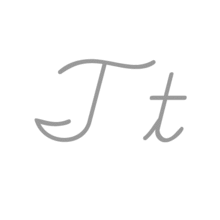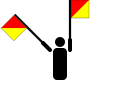T
|

T (named tee /ˈtiː/[1]) is the 20th letter in the modern English alphabet and the ISO basic Latin alphabet. It is the most commonly used consonant and the second most common letter in English language texts.[2]
History
| Phoenician Taw |
Etruscan T |
Greek Tau |
|---|---|---|
| |
|
|
Taw was the last letter of the Western Semitic and Hebrew alphabets. The sound value of Semitic Taw, Greek alphabet Tαυ (Tau), Old Italic and Latin T has remained fairly constant, representing [t] in each of these; and it has also kept its original basic shape in all of these alphabets.
Use in writing systems
English
In English, ⟨t⟩ usually denotes the voiceless alveolar plosive (International Phonetic Alphabet and X-SAMPA: /t/), as in tart, tee, or ties, often with aspiration at the beginnings of words or before stressed vowels.
The digraph ⟨ti⟩ often corresponds to the sound /ʃ/ (a voiceless palato-alveolar sibilant) word-medially when followed by a vowel, as in nation, ratio, negotiation, and Croatia.
The letter ⟨t⟩ corresponds to the affricate /t͡ʃ/ in some words as a result of yod-coalescence (for example, in words ending in "-ture", such as future).
A common digraph is ⟨th⟩, which usually represents a dental fricative, but occasionally represents /t/ (as in Thomas and thyme.)
Other languages
In the orthographies of other languages, ⟨t⟩ is often used for /t/, the voiceless dental plosive /t̪/ or similar sounds.
Other systems
In the International Phonetic Alphabet, ⟨t⟩ denotes the voiceless alveolar plosive.
Related characters
Descendants and related characters in the Latin alphabet
Ancestors and siblings in other alphabets
- 𐤕 : Semitic letter Taw, from which the following symbols originally derive
Derived signs, symbols and abbreviations
- ™ : Trademark symbol
- ₮ : Mongolian tögrög
- ₸ : Kazakhstani tenge
Computing codes
| Character | T | t | ||
|---|---|---|---|---|
| Unicode name | LATIN CAPITAL LETTER T | LATIN SMALL LETTER T | ||
| Encodings | decimal | hex | decimal | hex |
| Unicode | 84 | U+0054 | 116 | U+0074 |
| UTF-8 | 84 | 54 | 116 | 74 |
| Numeric character reference | T | T | t | t |
| EBCDIC family | 227 | E3 | 163 | A3 |
| ASCII 1 | 84 | 54 | 116 | 74 |
- 1 Also for encodings based on ASCII, including the DOS, Windows, ISO-8859 and Macintosh families of encodings.
Other representations
References
- ↑ "T", Oxford English Dictionary, 2nd edition (1989); Merriam-Webster's Third New International Dictionary of the English Language, Unabridged (1993); "tee", op. cit.
- ↑ Lewand, Robert. "Relative Frequencies of Letters in General English Plain text". Cryptographical Mathematics. Central College. Retrieved 2008-06-25.
External links
 Media related to T at Wikimedia Commons
Media related to T at Wikimedia Commons The dictionary definition of T at Wiktionary
The dictionary definition of T at Wiktionary The dictionary definition of t at Wiktionary
The dictionary definition of t at Wiktionary


